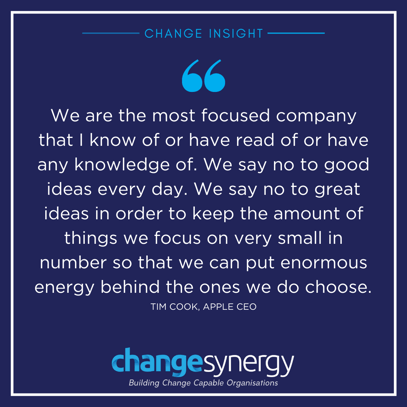When Steve Jobs returned to Apple in 1997, he took their product line from 350 down to 10. He chose to make 10 excellent products and ditch the remaining 340.
Jobs famously said, “People think focus means saying yes to the thing you’ve got to focus on. But that’s not what it means at all. It means saying no to the hundred other good ideas that there are.”
This is a bold leadership style that would reduce, if not eliminate, a lot of change fatigue.
“If you have more than three priorities, you have none”
I agree with Jim Collins. In my own life, I know that on a typical weekday I can usually accomplish three things:
- Work (that’s usually the biggest chunk of the day)
- Look after my family – this means doing the drop-off or the pick-up, then dinner and bedtime
- Look after me, which usually means exercise and meditation first thing in the morning
When I try to do more than these three things – say, catch up with friends, or a doctor’s appointment – something has to give. Either I squeeze work, I hand-off family responsibilities, or I don’t exercise.
I’ve learned that doing more than three big things in a day is a recipe for stress and doing things poorly.
What’s true at home is true at work, too. Not adhering to this principle is what’s behind a lot of change fatigue.
Working life can be like drinking from a firehose
It’s not uncommon for teams to be juggling organisation-wide priorities (a major transformation, an office move) alongside department-specific priorities (eliminating manual processes, migrating to new customer statements, product changes) on top of the whirlwind of BAU (performance reviews, supporting customers, upskilling new starters) – all at the same time.
And then there’s COVID – doing all the above whilst navigating an ever-changing landscape of what’s permitted, what isn’t, and sometimes home-schooling.
Is it any wonder that the risk of change fatigue is higher than ever?
Change fatigue and its consequences
Change fatigue is actually a consequence of change saturation: there’s so much going on that it negatively impacts individuals.
Said differently: it happens when the demand for change exceeds the available capacity to absorb it.
We like Daryl Conner’s bath sponge analogy: a fatigued workforce is like a bath sponge that’s already full of water. No matter how much more water you pour onto the sponge, it can’t take any more.
The consequences go beyond a tired, disengaged workforce: performance drops, customer satisfaction goes down, customers leave, and more focused competitors leap ahead.
[Related article: Is Change Fatigue an Excuse?]
[Related article: How to Win the Balancing Act: Change Demand and Capacity Management]
That feels like my world…but can you prove it?
Chris McChesney, in 4 Disciplines of Execution, says that the whirlwind of urgent activity required to keep things running usually devours most available capacity. Considering this, he believes that in addition to BAU we can only manage two to three initiatives well. Anything more than that, and performance suffers.
In our own research over the last three years, capacity management has been the #1 risk to organisations successfully implementing change.
In short, yes.
How to overcome change saturation (and change fatigue)
If you feel your organisation is experiencing change saturation, here’s what we recommend.
1. Ruthlessly manage priorities
- Develop and get buy-in for a prioritisation matrix
This goes beyond simple benefits and cost; it’s important to consider the relative benefits or value and cost or effort of a portfolio of initiatives. (Most people can do a cost-benefit analysis; you get actual buy-in when a group of people debates the relative positioning of the initiatives.)
Then:
- Eliminate “pet projects” or anything that’s not aligned to a clear strategic goal or business imperative
- Postpone or eliminate discretionary projects
2. Use a structured approach to managing your portfolio of change
- Take a “portfolio view” of all the change efforts underway
- Do capacity assessments to determine if resources are available to plan and manage the implementation, as well as to absorb the change
- Ensure initiatives are resourced appropriately (if it’s important, it shouldn’t be something team members do “in their spare time”)
3. Actively sponsor what you do prioritise
Our research tells us that change leaders can be the #1 contributor to change success – or the biggest obstacle. If you’re an active, engaged sponsor, chances are your direct reports will also make it a priority.
[Related article: What’s Missing from Leadership Development?]
4. Ensure that benefits are measured and sustainment mechanisms are in place
A project is “over” when benefits have been achieved, not the project implementation date.
It’s important to have reinforcement mechanisms in place after the project team rolls off. This can include things like:
- Ensuring that the way performance is measured aligns with the new ways of working
- Measuring the adoption of new ways of working
- Other organisational systems and processes are aligned and support the new ways of working
- Transferring change responsibility from the project team to the line organisation
5. Proactively manage resistance
Resistance occurs when we feel we’re losing control of a situation. We instinctively “slam on the brakes,” and when this happens, it can be difficult to create any acceleration.
As uncomfortable as this may be, it’s a normal human response. Educate your managers so that they can navigate resistance, rather than wasting time and energy trying to eradicate it.
Generally speaking, the greater the level of disruption, the higher the resistance.
Shouldn’t we be doing these things anyway?
Absolutely!
These are all best practices in general – but they’re essential to overcoming or reducing change saturation and change fatigue.
When they aren’t done, change efforts “collide” and put pressure on teams, with the effect of – you guessed it – change saturation, leading to change fatigue.
[Related article: Avoid Overload by Improving Capacity for Change & Managing Demand]
The courage to say “no”

It absolutely takes courage to say “no,” or to pause or cancel initiatives into which money has already been spent.
But if everything is a priority, then nothing is.
Jobs’ philosophy is alive and well today. Tim Cook, Apple’s current CEO, also loves to say “no”: “We say no to good ideas everyday. We say no to great ideas to keep the amount of things we focus on very small in number so that we can put enormous energy behind the ones we do choose.”
Coming to terms with all this
If you’re having trouble prioritising or taking a portfolio view of change, we can help. We built a tool to solve that problem – check out ChangeViz.



